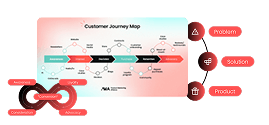As you progress through the product marketing field, expectations shift dramatically. Not only in the scope of your responsibilities, but in the mindset and influence you bring to the organization. Understanding these changes is essential for anyone aiming to grow in their product marketing career.
While job titles vary across companies – what one organization calls a Senior Product Marketing Manager, another may call a Product Marketing Team Lead – the core capabilities at each stage remain consistent.
This guide outlines the progression from Associate PMM to VP, highlighting how your expertise, leadership, and strategic vision should evolve at every step.
Associate Product Marketing Manager (APMM)
At the entry level, you are a hands-on contributor, learning the fundamentals of both the craft and the business. Your primary focus is building knowledge of your company’s products, the market, the competitive landscape, and how your role supports the bigger picture.
Your responsibilities may include:
- Supporting product launches by creating basic content such as datasheets, FAQs, or partner communications under the guidance of senior PMMs.
- Learning the customer personas and understanding how they connect to product features and benefits.
- Collaborating across teams, shadowing meetings with sales, product, and marketing to see how information flows.
- Collecting and organizing competitive intelligence to help shape messaging.
- Building foundational skills in research, content creation, and market analysis.
Success at this level comes from curiosity, a willingness to dive into new tools and data, and an eagerness to learn from more experienced team members. Your goal is to become a dependable executor who delivers high-quality work on time.
Product Marketing Manager (PMM)
The PMM role is where you shift from supporting others’ strategies to owning your own. You are trusted to manage specific products or market segments, running GTM initiatives from planning to execution.
Your responsibilities often include:
- Owning go-to-market plans for a product or product line, including launch timelines, key messages, and channel strategies.
- Creating product positioning and messaging that reflects market needs and differentiates from competitors.
- Working directly with sales to develop enablement tools, competitive battlecards, and pitch decks.
- Analyzing product performance and market data to refine campaigns and identify growth opportunities.
- Leading cross-functional collaboration for your product area, ensuring alignment between marketing, product, and sales.
At this stage, you’re expected to work independently, apply critical thinking to solve problems, and deliver measurable results. You begin to be seen not just as a marketer, but as a business partner who can connect the dots between market insight and revenue impact.
Senior Product Marketing Manager (Sr. PMM)
The senior role demands leadership, whether or not you have direct reports. You set strategic direction for your product area, mentor junior PMMs, and act as a subject matter expert both internally and externally.
Your responsibilities expand to:
- Leading GTM strategies for multiple products or a major business segment, ensuring each is aligned with corporate objectives.
- Delivering differentiated thought leadership in your market, such as whitepapers, webinars, or conference presentations.
- Refining personas and buyer journeys based on research, and applying those insights to both product roadmaps and marketing plans.
- Driving cross-functional alignment, especially between product, sales, and marketing leadership.
- Evaluating performance data to optimize messaging, positioning, and campaign execution.
In this role, you are often the “voice of the market” in product strategy discussions. Your ability to connect market trends, customer needs, and product capabilities makes you a strategic advisor across the business.
Director of Product Marketing
Directors move fully into leadership, managing teams, portfolios, and processes. Your role is to ensure that product marketing’s work not only meets high standards but also advances the company’s growth agenda.
You’ll focus on:
- Setting strategic direction for product positioning, launch prioritization, and market engagement.
- Building and leading high-performing teams, providing coaching, career development, and a clear vision.
- Owning portfolio-level GTM plans and ensuring they are scalable, repeatable, and adaptable to changing market conditions.
- Driving cross-functional orchestration, ensuring product, sales, marketing, and customer success are in sync.
- Anticipating market shifts and proactively adjusting strategies to stay ahead of competitors.
- Serving as a trusted advisor to executives, providing market insights that shape investment and product decisions.
At this level, success is about influence, operational excellence, and your ability to build systems that deliver consistent results without needing your constant oversight.
VP of Product Marketing
The VP role sits at the intersection of market leadership and executive strategy. You’re responsible for defining how the company competes, wins, and grows in its chosen markets.
Your remit includes:
- Owning the company’s overarching market narrative and ensuring alignment across all business units and geographies.
- Guiding multi-year growth strategies, leveraging deep market insight to shape product portfolio investments.
- Overseeing global GTM execution, ensuring local adaptations maintain brand and message integrity.
- Influencing C-suite peers by connecting marketing strategy to revenue, profitability, and market share outcomes.
- Representing the company externally, whether speaking to industry analysts, media, partners, or at flagship events.
- Shaping industry direction, positioning the company as a market leader rather than a follower.
VPs must balance vision with disciplined execution. Your success is measured not by the number of campaigns run, but by the market positions won and the sustainable growth achieved.
How core skills evolve across the career path
The journey from Associate to VP is marked by a steady progression across key product marketing competencies:
1. Market insight
Early on, you’re learning the basics of the market landscape. By the time you reach a senior role, you’re actively shaping market segments, anticipating trends, and guiding the company’s competitive positioning.
2. Product expertise
Beginners focus on understanding product features and customer benefits. Leaders develop compelling product narratives, identify strategic opportunities, and drive portfolio-level decisions.
3. Persona development
From learning basic persona definitions to creating sophisticated, research-backed buyer archetypes, persona expertise matures into a powerful tool for aligning GTM strategies with customer needs.
4. Buyer’s journey mastery
You progress from observing the buying process to designing strategies that influence it, ensuring every touchpoint drives engagement and conversion.
5. Product launch leadership
Where an APMM supports launches, senior leaders architect launch strategies, integrate them into corporate priorities, and optimize based on performance data.
6. Go-to-market planning
Your GTM planning skills evolve from contributing ideas to building multi-channel strategies that align teams and drive measurable business impact.
7. Value proposition development
This moves from understanding existing value propositions to crafting and validating new ones that differentiate products in the market.
8. Asset and content creation
From building basic product materials to shaping thought leadership content, your ability to create and guide high-impact assets grows significantly.
9. Process and cross-functional interlock
Entry-level PMMs learn how different teams fit together. Senior leaders design frameworks that enable seamless collaboration and scale execution across global markets.
Skills that matter at every level
Regardless of your role, these capabilities remain essential:
- Strong written and verbal communication
- Cross-functional collaboration and relationship building
- Creative problem solving
- Strategic and analytical thinking
- Empathy for customers
- Research and data interpretation
- Storytelling and content creation
Final thoughts
Product marketing offers a rare dual impact: shaping what companies build and how markets respond. Master the expectations at each level, focus on the skills that truly matter, and you'll build a career that influences products, markets, and outcomes at every stage.


















 Follow us on LinkedIn
Follow us on LinkedIn




.svg)
Start the conversation
Become a member of Product Marketing Alliance to start commenting.
Sign up now